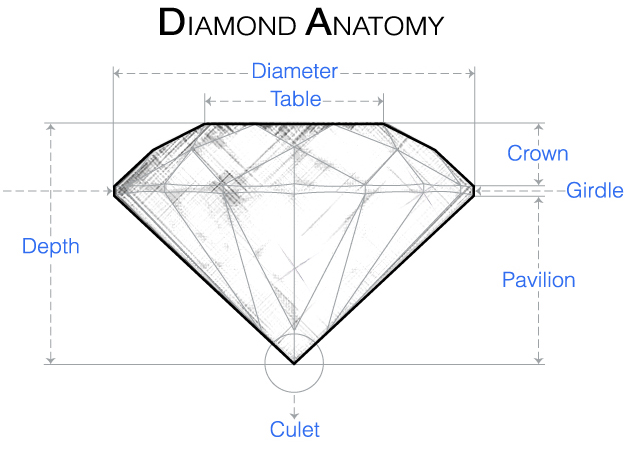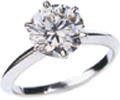Loose Diamonds
Diamond Guides
- The 4 C's and More
- Diamond Shape
- Diamond Cut
- Diamond Color
- Diamond Clarity
- Diamond Carat Size
- GIA Certification
- GIA Cut Grades
Jewelry Guides
- Engagement Ring Guide
- Diamond Tips
- Caring For Your Jewelry
- Tips on Getting Her Ring Size
- How To Build Your Fine Diamond Jewelry Wardrobe
- Diamond & Jewelry Appraisals
- Branded Diamonds
Education Videos
Design Your Engagement Ring
A. Fishman Difference
- Direct Diamond Prices
- Loose Diamond Manufacturer
- A+ Rating From BBB
- Customer Testimonials
- 100% Money Back Guarantee
- FREE FedEx Overnight Shipping
- Lifetime Warranty
- 2% Discount for Bank Wires
- Why No "Shopping Cart"
Expert Guidance
- Expert Guidance
- 212-869-0085
Diamond Cut Grades
At A. Fishman & Son, all of our diamonds have been graded by the Gemological Institute of America (GIA). The GIA diamond grading laboratory is the most respected and prestigious in the world.
GIA Diamond Cut Grades
GIA bases their new diamond cut grades (as of Jan. 2006) on a combination of face-up appearance, design and craftsmanship elements that all contribute to the diamond's fire and brilliance. They employ a predictive computer model, based on over 70,000 individual diamond observations and 38.5 million proportion sets, to determine a diamond's brilliance based on its interrelated measurements. Most GIA diamonds graded prior to January 1st, 2006 will not have a laboratory-assigned cut grade. The GIA cut grade system includes ratings of Excellent, Very Good, Good, Fair and Poor. GIA does not assign an Ideal cut and an Excellent rating is their highest grade. Learn more about the GIA Diamond Grading Report and Diamond Dossier®.
These five diamond cut grades assigned by the GIA describe the Cut of a round diamond. For fancy shaped diamonds (any shape other than a round brilliant), where the GIA does not assign a Cut Grade, A. Fishman & Son examines each diamond and assigns our own cut grade based on our own visual examination of the diamond and its polish, symmetry and visual brilliance qualities. [We don’t include poor cut grades in our inventory.]
Excellent- This diamond is cut to the finest proportions as determined by its face-up appearance, design, and craftsmanship. It reflects nearly all light as fire and brilliance.
Very Good- This diamond has been cut to allow it to reflect nearly all light as fire and brilliance.
Good- This diamond has been cut to allow it to reflect most light that enters.
Fair- This diamond has been cut to yield more carat weight from the diamond rough. A fair cut will produce some brilliance, but will not be as brilliant as a higher grade of cut.
Not Available (N/A) - The GIA does not issue cut grades for fancy shape diamonds (any shape other than a round brilliant). For fancy shaped diamonds we examine each diamond and assign our own cut grade based on our own visual examination of the diamond and its polish, symmetry and visual brilliance qualities. Where no cut grade is shown for a particular fancy shape diamond, we are in the process of evaluating that diamond.
GIA Diamond Cut Grading System: Excellent, Very Good, Good, Fair, Poor
The GIA Diamond Cut Grading System assigns one of these five grades to describe the overall cut quality of a standard round brilliant diamond in the GIA D-to-Z color range, and the Flawless-to-I3 clarity range. Each cut grade represents a range of proportion sets and diamond appearances, each of which may conform in different ways to the characteristics of that grade.
The GIA has concluded that there are many different proportion sets that provide top-grade diamonds and even wider ranges of proportions that are capable of providing pleasing upper-middle to middle-grade diamonds.
And while it is important to consider many components when assessing the overall cut appearance and quality of round brilliant diamonds, an individual's personal preferences also play a role. The GIA Cut Grading System provides an objective assessment of a diamond's overall cut quality. Because each cut grade represents a wide range of proportion sets, the system also gives individuals the freedom to choose which particular appearance they prefer.
GIA Diamond Cut Grading Procedure
Cut is the factor that fuels a diamond’s fire, sparkle, and brilliance.
The traditional 58 facets in a round brilliant diamond, each precisely cut and defined, are as small as two millimeters in diameter. But without this precision, a diamond wouldn’t be nearly as beautiful. The allure of a particular diamond depends more on cut than anything else.
Though extremely difficult to analyze or quantify, the cut of any diamond has three attributes: brilliance (the total light reflected from a diamond), fire (the dispersion of light into the colors of the spectrum), and scintillation (the flashes of light, or sparkle, when a diamond is moved).
An understanding of diamond cut begins with the shape of a diamond. The standard round brilliant is the shape used in most diamond jewelry. All others are known as fancy shapes. Traditional fancy shapes include the marquise, pear, oval, emerald cuts, hearts, cushions, radiant,
As a value factor, though, cut refers to a diamond’s proportions, symmetry

A round brilliant cut diamond has 57 or 58 facets, the 58th being a tiny flat facet at the bottom of the pavilion that’s known as the
How does pavilion depth affect a diamond's cut?
The distance from the bottom of the girdle to the culet is the pavilion depth. A pavilion depth that’s too shallow or too deep will allow light to escape through the sides or the bottom of the stone. A well-cut diamond will direct more light through the crown.
|
Shallow Cut Diamonds When a diamond is cut too shallow, light leaks out of the bottom, brilliance is lost and the diamond appears watery, glassy and dark. A diamond with these characteristics is referred to as a "fisheye". |
|
|
Deep Cut Diamonds When a diamond is cut too deep, light leaks out of the sides, brilliance is lost and the center of the diamond will appear to be dark. A diamond with these characteristics is referred to as a "nailhead". |
|
Selecting a Diamond Cut Grade
- It is a misconception that only diamonds with excellent polish and excellent symmetry and excellent cut grade are the prettiest and most desirable diamonds to purchase. The fact is that a diamond with very good polish and symmetry can receive an Excellent cut grade and a diamond with excellent polish and symmetry can receive a Very God cut grade.
- It is a misconception that all diamonds with Excellent cut grade are pretty and desirable. Diamonds can receive an Excellent cut grade and be too deep or not have the appropriate diameter for its weight.
- To be certain that you are purchasing the right diamond, and not just the right piece of paper, you must consult a reputable diamantaire – a person who is an expert in buying and selling diamonds; one who has invested his own money over many years in purchasing diamonds. We at A. Fishman & Son are experienced 3rd generation diamantaires and we can assist you in purchasing the right diamond at the right price.
- Be wary of sellers who tout “branded” cut grades such as “Super Ideal,” “Signature Ideal,” “Hearts and Arrows,” “True Hearts,” and others. These branded cut grades are not necessarily going to be prettier than a GIA graded Excellent or even Very Good cut graded diamond. They will be more expensive. You must consult with an expert diamantaire who truly understands diamonds in order to assure yourself of purchasing the prettiest diamonds, not just a diamond with a great label.
Loose Diamonds
Shapes of Diamonds
Diamond Videos-New
About our Loose Diamonds
Perfect Diamonds
Pretty Diamonds
Round Cut
Princess Cut
Cushion Cut
Radiant Cut
Emerald Cut
Asscher Cut
Pear Shape
Oval Shape
Marquise Shape
Heart Shape
Diamond Jewelry
Brooches
Bracelets
Earrings
Engagement
Necklaces and Pendants
Wedding Rings
Custom Designed Jewelry
Diamond Guides
Diamond Guide - The 4 C's
Ethics of Lab-Grown Diamonds
Purchase: Beyond the Four C's
Diamond Guide Videos
Engagement Ring Guide
Understanding GIA Certificates
Understanding GIA Cut Grades
Pretty Diamonds
Diamond Clarity Enhancements
Conflict Free Diamonds
Identifying Fake Diamonds
Diamond Tips
Diamond Jewelry Appraisals
Diamond & Jewelry Care
Gift Giving
Beyond the 4 C's
Jewelry and Diamonds to Wear for a Lifetime - Not Just a Season!™
 A. Fishman & Son • 580 Fifth Avenue, Ste 402 • New York, NY 10036 • 212-869-0085
A. Fishman & Son • 580 Fifth Avenue, Ste 402 • New York, NY 10036 • 212-869-0085
Copyright © 2011-2022 A.Fishman & Son. All Rights Reserved. Website by YLWConsulting








